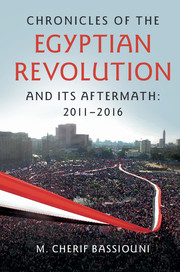Book contents
- Frontmatter
- Dedication
- Contents
- Preface
- Acknowledgments
- List of Abbreviations
- Introduction
- 1 The Early Stage of the Revolution
- 2 Mubarak Relinquishes the Presidency and the SCAF Assumes Power
- 3 A Prelude to Democracy: 2011–2012 Elections
- 4 The Morsi Presidency: June 30, 2012 to July 3, 2013
- 5 The Military's Return to Power and the El-Sisi Presidency
- 6 2015Legislative Elections and the Changing Civilian Political Landscape
- 7 The Military Institution: Its Power, Influence, and Culture
- 8 Violence and Repression
- 9 The Accountability Gap
- 10 The Justice System in Crisis
- 11 The Constitutional Quagmire
- 12 Demographics, Education, and the Economy
- 13 Geopolitical Factors
- 14 Concluding Assessment
- Pictures of the Egyptian Revolution and Related Events
- Bibliography
- Index
5 - The Military's Return to Power and the El-Sisi Presidency
Published online by Cambridge University Press: 24 November 2016
- Frontmatter
- Dedication
- Contents
- Preface
- Acknowledgments
- List of Abbreviations
- Introduction
- 1 The Early Stage of the Revolution
- 2 Mubarak Relinquishes the Presidency and the SCAF Assumes Power
- 3 A Prelude to Democracy: 2011–2012 Elections
- 4 The Morsi Presidency: June 30, 2012 to July 3, 2013
- 5 The Military's Return to Power and the El-Sisi Presidency
- 6 2015Legislative Elections and the Changing Civilian Political Landscape
- 7 The Military Institution: Its Power, Influence, and Culture
- 8 Violence and Repression
- 9 The Accountability Gap
- 10 The Justice System in Crisis
- 11 The Constitutional Quagmire
- 12 Demographics, Education, and the Economy
- 13 Geopolitical Factors
- 14 Concluding Assessment
- Pictures of the Egyptian Revolution and Related Events
- Bibliography
- Index
Summary
THE TAKEOVER
On July 3, 2013, hours after Mohamed Morsi had been removed from office and imprisoned, General Abdel Fattah el-Sisi appeared in a well-choreographed scene inside the presidency building.
The symbolism of the scene is striking even today. El-Sisi stands in uniform behind a podium, with the flags of the armed forces behind him, in front of the stairs leading up to the office of the president. Flanking el-Sisi are two rows of dignitaries consisting of fourteen people, including the Grand Shiekh of al-Azhar, Sheikh Ahmed el-Tayeb, and Pope Tawadros II, the head of the Coptic Church, sitting side by side in a clear demonstration of religious unity. Also present are Adly Mansour, then-chief justice of the Constitutional Court, who was on that occasion appointed by el-Sisi as temporary president, and Mohamed el-Baradei, a leader of the liberal/nationalistic/pro-democratic movement, who was appointed as temporary vice president. Seven senior generals representing the branches of the armed forces are also present. The ceremony is solemn, formal, and dignified, and everything about it conveys a sense of legitimacy.
El-Sisi was later made field marshal by Temporary President Adly Mansour, whom el-Sisi had appointed on this occasion to that new post. General el-Sisi, in his capacity as the military commander in chief, confirmed the removal of elected president Morsi on behalf and at the request of the Egyptian people. He retraced the efforts of the Military Institution to seek some accommodation and resolution of disputes between the Morsi presidency and the political parties, factions, and movements that opposed him, as well as the Egyptian people. He stressed that the armed forces had no intention to enter the political arena but did have an obligation toward the Egyptian people, one that clearly required action to address the ongoing tension between the Morsi regime and the people that culminated in the massive Tamarod protests of June 30.
He then unveiled the road map meant to ensure the transition toward democracy and the rule of law.
- Type
- Chapter
- Information
- Publisher: Cambridge University PressPrint publication year: 2016



